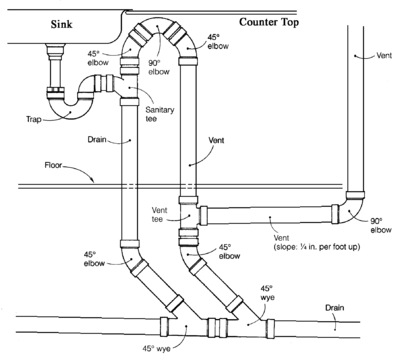
Chicago Loop (plumbing)
Encyclopedia

Trap (plumbing)
In plumbing, a trap is a U-, S-, or J-shaped pipe located below or within a plumbing fixture. An S-shaped trap is also known as the S-bend invented by Alexander Cummings in 1775 but became known as the U-bend following the introduction of the U-shaped trap by Thomas Crapper in 1880. The new U-bend...
installed on an under counter
Countertop
Countertop usually refers to a horizontal worksurface in kitchens or other food preparation areas, bathrooms or lavatories, and workrooms in general. It is frequently installed upon and supported by cabinets...
island sink
Sink
A sink is a bowl-shaped plumbing fixture used for washing hands, for dishwashing or other purposes. Sinks generally have taps that supply hot and cold water and may include a spray feature to be used for faster rinsing...
or other similar applications where a conventional vertical vent stack is not feasible.
Function
As with all drains, ventilation must be provided to allow the flowing waste waterWastewater
Wastewater is any water that has been adversely affected in quality by anthropogenic influence. It comprises liquid waste discharged by domestic residences, commercial properties, industry, and/or agriculture and can encompass a wide range of potential contaminants and concentrations...
to displace the sewer gas
Sewer gas
Sewer gas is a complex mixture of toxic and non-toxic gases produced and collected in sewage systems by the decomposition of organic household or industrial wastes, typical components of Sewage....
in the drain and then the vacuum
Vacuum
In everyday usage, vacuum is a volume of space that is essentially empty of matter, such that its gaseous pressure is much less than atmospheric pressure. The word comes from the Latin term for "empty". A perfect vacuum would be one with no particles in it at all, which is impossible to achieve in...
which would otherwise form as the water flows down the pipe. A Chicago Loop provides an elegant solution: when the drain is opened, water displaces the air to the tee. The water will flow down while the air is displaced upward to the vent. After the water has passed, air will be replenished through the vent. The key to a functional Chicago Loop is that the top elbow must be as close to, if not higher than, the "flood level" (peak possible drain water level) as possible. This ensures the vent will never become waterlogged. The second way provides a simpler path for the return airflow after the water has passed the drain.
Cost
The cost of installation is high because of the number of elbows and small pieces of pipe required; with modern plastic drain pipes, the largest outlay will be labor. Street elbowStreet elbow
A street elbow is a type of plumbing or piping fitting intended to join a piece of pipe and another fitting at an angle. The difference between a street elbow and a regular elbow is the nature of the connections on either end.A regular elbow has a female hub or FIP connection on both ends...
s will be helpful.
Alternatively, installation of an air admittance valve can be used in some cases to keep costs down.
Alternately if moving sink to an island sink, install the P-trap below the floor of the island and vent off the top of the drain. Attach toward the trap and reverse 180 degrees so any water in the vent flows down the drain. Slope drain down, slope vent up, and attach to existing vent from previous existing fixture that is now abandoned. Patch previously existing drain to become vent. In Canada, the national plumbing code requires that the minimum trap arm be at least 2 times the pipe diameter, (I.E 1.25 inch trap needs a 2.5 inch trap arm, 1.5 needs a 3 inch pipe etc.) and that the vent pipe be one size larger than the drain that it serves, also a cleanout is required on both the vent and the drain. The reason for this is in the event of a plugged sink, the waste water will back up and go down the vent, possibly plugging the vent (as it is under the countertop)for that reason a clean-out would permit the cleaning of the pipes.

